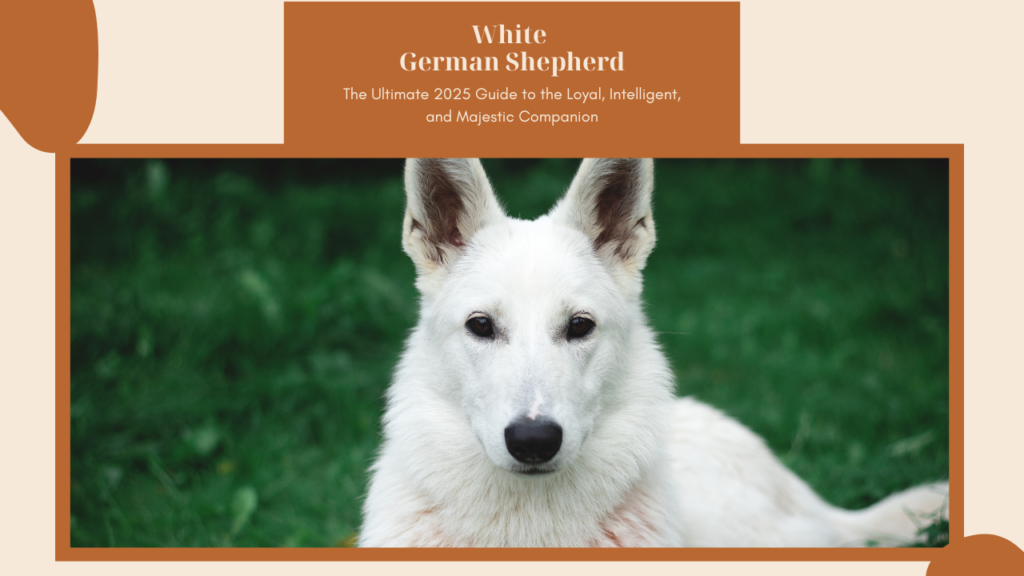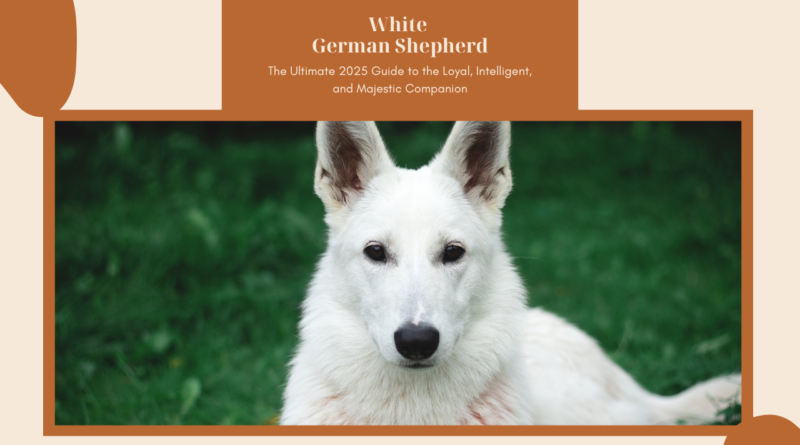White German Shepherd: The Ultimate 2025 Guide to the Loyal, Intelligent, and Majestic Companion
When it comes to intelligent, loyal, and beautiful dog breeds, few can match the charm of the White German Shepherd. Known for its snow-white coat, striking appearance, and strong personality, this breed has captured the hearts of dog lovers across the USA and beyond. Unlike the traditional black-and-tan German Shepherd, the white variety stands out not only because of its looks but also because of its gentle yet protective temperament.
In this ultimate guide, we’ll explore everything you need to know about the White German Shepherd — from its fascinating history and temperament to training, grooming, health, costs, and adoption tips. Whether you’re considering bringing home a White German Shepherd puppy or simply want to learn more about the American White Shepherd, this guide is for you.

What Is a White German Shepherd?
The White German Shepherd is a color variation of the German Shepherd breed, characterized by its pure white coat. Unlike popular myths, this breed is not albino; the white coat is caused by a recessive gene that dilutes the coat color without affecting the dog’s health or abilities.
Despite its unique appearance, the White German Shepherd shares the same lineage as the classic German Shepherd, making it highly intelligent, trainable, and versatile. The breed can excel in various roles, including family companion, therapy dog, service dog, and even police or protection work.
The History of the White German Shepherd
White-coated German Shepherds first appeared in Germany in the late 19th century. One of the earliest documented white dogs was Greif von Sparwasser, born in 1882. Early German Shepherd breeders initially considered white coats undesirable, leading to limited recognition in Europe.
However, North American breeders appreciated the beauty and uniqueness of these dogs. Over time, enthusiasts preserved the bloodline, and in 1999, the American White Shepherd was officially recognized as a separate breed by the United Kennel Club (UKC). Today, the White German Shepherd has gained global popularity, admired for its combination of beauty, loyalty, and intelligence.
Physical Appearance and Characteristics
The White German Shepherd is a majestic dog with a commanding presence. Its pure white coat is its most distinguishing feature, but its overall structure mirrors that of traditional German Shepherds.
Key Features:
- Height: 22–26 inches (males), 22–24 inches (females)
- Weight: 65–90 lbs (males), 50–70 lbs (females)
- Coat: Dense double coat, medium to long, designed for weather protection
- Eyes: Almond-shaped, typically dark brown
- Ears: Upright and pointed
- Tail: Bushy, carried low when relaxed
This combination of size, posture, and snowy coat gives the breed a regal, elegant appearance, making it stand out in both family and show settings.
Temperament and Personality
The White German Shepherd is well-known for its friendly, loyal, and intelligent temperament. This breed thrives on social interaction, mental stimulation, and physical activity.
Key Traits:
- Loyal and Protective: Forms deep bonds with family members and can act as a vigilant guardian.
- Gentle with Children: Patient and affectionate, making it a great family dog.
- Highly Intelligent: Quick learners who excel in obedience, agility, and working roles.
- Energetic and Playful: Requires daily exercise to prevent boredom.
- Alert but Calm: Naturally wary of strangers, but not overly aggressive.
With proper socialization and training, White German Shepherds integrate seamlessly into family life and can be trusted around children and other pets.
Training a White German Shepherd
Training is essential to harness the intelligence and energy of a White German Shepherd. These dogs respond well to consistent, positive reinforcement-based training.
Training Tips:
- Start Early: Begin obedience training as a puppy to instill good habits.
- Positive Reinforcement: Use treats, praise, and toys to motivate learning.
- Socialization: Introduce them to different people, pets, and environments.
- Basic Commands: Teach sit, stay, come, and heel.
- Advanced Training: Engage them in agility, tracking, or protective work.
Regular training sessions, combined with mental stimulation like puzzle toys, help prevent destructive behavior and keep their minds sharp.
Exercise Requirements
A White German Shepherd is a high-energy breed that requires at least 60–90 minutes of daily exercise. Ideal activities include:
- Daily Walks or Runs: Keeps them physically fit.
- Fetch or Frisbee: Engages both body and mind.
- Agility or Obedience Training: Offers mental stimulation.
- Hiking or Outdoor Adventures: Perfect for active owners.
- Swimming: Great low-impact exercise for joints.
Without sufficient exercise, these dogs can develop anxiety, restlessness, or behavioral issues.
Grooming and Coat Care
The White German Shepherd’s thick coat is beautiful but requires regular maintenance.
Grooming Routine:
- Brushing: 3–4 times per week; daily during shedding season.
- Bathing: Every 6–8 weeks or as needed.
- Ear Care: Weekly cleaning to prevent infections.
- Nail Trimming: Every 3–4 weeks.
- Teeth Brushing: 2–3 times per week.
Regular grooming keeps their coat healthy, prevents mats, and reduces shedding around the house.
White German Shepherd Puppies
Owning a White German Shepherd puppy is a rewarding experience. Puppies are active, curious, and eager to explore their environment.
Tips for Raising a Puppy:
- Puppy-Proof Your Home: Remove dangerous items and secure wires.
- Crate Training: Helps with housebreaking and provides a safe space.
- Socialization: Introduce to people, pets, and different environments.
- Routine Vet Care: Vaccinations and health checks are essential.
- Patience and Love: Puppies require time and guidance to develop proper behavior.
Well-raised puppies grow into confident, loyal, and loving adults.
White German Shepherd Price in the USA
The cost of a White German Shepherd varies depending on breeder quality, pedigree, and location:
- Pet Quality: $800–$1,200
- Show or Breeding Quality: $1,500–$3,000+
- Adoption/Rescue: $200–$500
Other ongoing expenses include food, veterinary care, grooming, training, and supplies. While the initial investment may seem high, the companionship and loyalty of a White German Shepherd are priceless.
Health Issues
Like all breeds, the White German Shepherd is prone to certain health issues. Responsible breeding and preventive care reduce risks.
Common Health Concerns:
- Hip Dysplasia: Joint issues common in large breeds.
- Elbow Dysplasia: Another joint-related condition.
- Degenerative Myelopathy: A spinal condition affecting mobility.
- Bloat (Gastric Dilatation): Life-threatening if untreated.
- Skin Allergies: Can be more visible on white coats.
Regular vet visits, proper diet, and exercise help keep them healthy and active.
Diet and Nutrition
A White German Shepherd needs a balanced, high-protein diet for optimal health:
- High-Quality Dog Food: Rich in protein, low in fillers.
- Balanced Diet: Include lean meats, vegetables, and grains.
- Feeding Schedule: Puppies 3–4 times per day, adults 2–3 times.
- Supplements: Omega-3s support coat and joint health.
- Hydration: Fresh water at all times.
Avoid overfeeding to prevent obesity, which can aggravate joint issues.
White German Shepherd vs American White Shepherd
Though very similar, subtle differences exist:
| Feature | White German Shepherd | American White Shepherd |
|---|---|---|
| Coat Color | Pure white | Pure white |
| Recognition | Color variation of GSD | UKC recognized breed |
| Temperament | Loyal, protective | Gentle, family-oriented |
| Popularity | Growing | Steady |
For most owners, the differences are minor, but breeders and enthusiasts may distinguish them based on official recognition standards.
Adoption and Rescue
Rescue and adoption are excellent options for giving a White German Shepherd a loving home.
Rescue Options:
- White German Shepherd Rescue (WGSR)
- German Shepherd Rescue & Adoptions (GSRA)
- Local animal shelters
Adoption fees are usually lower than buying from a breeder and include vaccinations and sometimes spaying/neutering.
Living Environment
White German Shepherds adapt well to different living situations if their needs are met:
- Homes with Yards: Ideal for play and exercise.
- Active Families: Perfect for owners who enjoy outdoor activities.
- Apartment Living: Possible with sufficient walks and mental stimulation.
- Companionship: Dislike being left alone for long periods.
Lifespan
White German Shepherds typically live 10–14 years, depending on genetics, care, and environment. Proper diet, exercise, and healthcare contribute to a long, healthy life.
Common Myths
- “They’re albino.” False. They carry a white coat gene, not albinism.
- “They’re weak.” False. They are just as strong as other GSDs.
- “They can’t work.” False. They excel in service, therapy, and protection roles.
Frequently Asked Questions
- Are White German Shepherds rare? — Yes, less common than black-and-tan varieties.
- Do they shed a lot? — Yes, especially during seasonal shedding.
- Can they live in hot climates? — Yes, with shade, water, and care.
- Are puppies expensive? — $800–$3,000 depending on quality.
- Do they have more health problems than standard GSDs? — No, similar risks.
Final Thoughts
The White German Shepherd is more than just a stunning dog — it’s a loyal companion, intelligent worker, and loving family member. With proper training, exercise, and care, this majestic breed brings unmatched joy, protection, and companionship to its owners.
Whether you’re seeking a White German Shepherd puppy, considering adoption, or simply admiring the breed, one thing is clear: they are one of the most loyal, intelligent, and beautiful dogs you can bring into your life.

